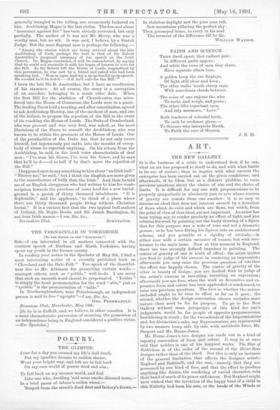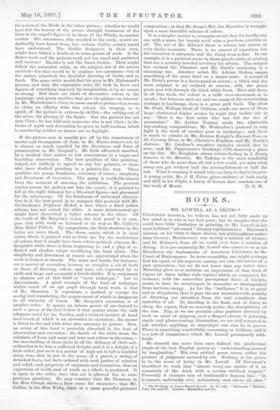ART.
THE NEW GALLERY.
IT is the business of a critic to understand first, if ho can,. what an art has proposed to itself to do, and with what limits in its use of nature ; then to inquire with what success the enterprise has been carried out on the given conditions; and afterwards, if he likes, but as a distinct problem, to raise previous qnestions about the choice of aim and the choice of limits. It is difficult for any one with prepossessions to be properly sympathetic or absolutely just to arts whose centres of gravity are remote from one another : it is so easy to dismiss an ideal that does not interest oneself by a detection of flaws which do exist and which are flaws, but which, from the point of view of that ideal, are not important. An artist has been trying, say, to render precisely an effect of light, and you criticise his work by pointing out the hasty drawing of a figure that for this purpose was a note of tone and not a dramatic person; or he has been fitting his figures into an architectural scheme, and you grumble at a rigidity of attitude,—in either case with a certain measure of reason, but with irre- levance to the main issue. Now at this moment in England, there are two strongly defined impulses in painting. The centre of gravity of one is truth of effect : the artist invites you first to judge of his success in rendering an impression; afterwards you may raise the previous question of whether the effect was happily chosen. The centre of gravity of the other is beauty of design : you are invited first to judge of the artist's success in inventing, inventing an expression ; afterwards you are free, when the work as decorative and ex- pressive form and colour has been applauded or condemned, to raise two previous questions. The first is, whether the nature included ought to be true to effect so far as it goes ; the• second, whether the design-convention chosen excludes more nature than need be for its purpose. To go to the New Gallery without some perspective of this kind for one's judgments, would be, for people of opposite prepossessions, bewildering in result ; for the two schools of the Impressionists and, for distinction's sake, say Expressionists, are represented by two masters hung side by side with antithetic, force, Mr. Sargent and Mr. Burne-Jones. Mr, Burne-Jones's two designs are made out in a kind of tapestry convention of ,form and colour. It may be at once said that neither is one of his happiest works. The Star of Bethlehem. is of the order of the second of the Briar-Rose designs rather than of the third. But this is only an instance of the general limitation that affects the designer artiste? Raphael and Botticelli, and the rest,—namely, that they are possessed by one kind of face, and that the effort to produce anything like drama, the rendering of varied character, robs their band of much of its power and charm. But Raphael might have wished that the invention of the happy knot of a child in this Nativity had been his own, or the heads of the Winds or
the action of the Bride in the other picture ; whether he would have felt the beauty of the severe straight treatment of the lines in the angel's figure or in those of the Winds, is another matter. His successors, who revelled in the curly, would un- doubtedly have hated them, but certain Gothic artists would have understood. The Gothic designers, in their turn, might have hinted a doubt as to some points of scale. Is the flower-work and the pattern-work not too small and scattered and various P Rheims is not the finest Gothic. Then might follow the naturalist critic, on the subject, not of the nature omitted—for that would be to confuse two questions—but of the nature admitted, the doubtful drawing of limbs, and so forth. The same critic would find his prey in Mr. Richmond's picture, and here the expressive note, the look in faces and figures of something imposed by imagination, is by no means so strong. But there are hints of decorative colour in the landscape and green marbles that give the picture an interest- In Mr. Waterhouse's Circe, to name another picture that seems to claim an affinity with this school, the staging, so to speak, of the picture is extremely skilful,—the setting•out of the scene, the placing of the figure. But the painter has not seen Circe ; he has half-seen some one who is not Circe ; in the frame of myth and decoration he gives us half-realism, which is convincing neither as dream nor as daylight.
If the picture-seer is usually put off by the remoteness of matter and strangeness of form in Mr. Burnc-Jones's art, he is almost as much repelled by the directness and force of presentation in Mr. Sargent's. He feels affronted, insulted, by a method that makes so few concessions to a vague and fumbling observation. The rare qualities of this painting, indeed, are unlikely to appeal to any but painters, or those who have studied painting in a painter-like way. These qualities are grasp, frankness, certainty of vision ; simplicity and directness of execution. The grasp is verifiable almost from the moment of entering the exhibition. The portrait carries across the gallery out into the court ; it is painted to tell at the right distance for a life-sized figure—not piecemeal for the microscope. Of the frankness of unbiassed observa- tion in it, the best proof is to compare this portrait with Mr. Orchardson's Professor Nichol, a case where a fixed yellow scheme has not suited the sitter. A more disinterested eye might have discovered a better scheme in the sitter. Of the truth of Mr. Sargent's vision, the best proof is to com- pare him with work so talented in its way as Mr. Collier's Miss Mabel Pollock. By comparison, the flesh-shadows in the latter are mere black. The dress, again, which is in local colour black, is painted with so little eye for the modulation of colour, that it might have been colour-printed, whereas Mr. Sargent's white dress is from beginning to end a play of re- flected and shadow colour modifying the local white. The simplicity and directness of means are appreciated when the work is looked at closely. The arms and hands, for instance, are a marvel of execution, because so complex a set of facts as those of drawing, colour, and tone, are expressed by so swift and large and economic a brush-stroke. It is customary to dismiss art of this kind as " mere technique." Let us discriminate. A good example of the kind of technique within reach of an apt pupil through hard work, is that of Mr. Shannon. It represents a method or receipt for seeing and translating, the acquirement of which is dangerous to all sincerity of vision. Mr. Sargent's execution is of another order. It means an inborn power of eye trained to such a. grasp of the fact before it that genius seems the only adequate word for the faculty, and a trained instinct of hand each touch of which is an invention in execution; the means is fitted to the end with what also amounts to genius. Now, an artist of this kind is probably absorbed in the heat of observation and execution ; the dazzle of the white dress, the relations of form and mass and tone and colour in the arms,— the marshalling of these facts in all the delicacy of their sub- ordination is to him a sufficient delight, and it is a delight of a high order, just as it is a matter of high art to tell a truthful story, true, that is, not in the sense of a parcel, a string of detached facts, but facts ordered with such justice of relation and relief, such propriety of emphasis and intonation, that an impression of truth, and of truth as a whole, is produced. It is open to the critic, once this art is allowed for, to raise previous questions. He may consider that Mr. Shannon, in his Miss Clough, shows a finer sense for character ; that Mr. Collier, in his Miss Welby, hints at a more graceful pictorial composition ; or that Mr. Swan's Mrs. Ian Hamilton is wrought upon a more beautiful scheme of colour.
It is a simpler matter to recognise an art that for hardly any one with a sense for beauty need raise a previous question at all. The art of Mr. Edward Stott is nature, but nature at very choice moments. There is no marvel of execution, but the execution is adequate, and the thing seen is fine. In one example, it is a pastoral scene in those purple mists of evening that are a recently invaded territory for artists. The subject has crossed the Channel, and Mr. Stott's rendering is a charming one. Another artist, Mr. Adrian Stokes, essays something of the same kind on a larger scale. A second of Mr. Stott's poems is a horse-pond at sunset ; a third, and the most original, is an orchard at sunrise, with the green grass just felt through the thick white frost. Here and there in all this work, the colour is a trifle over-sweetened, so to speak; but between such art and too many of the surrounding mishaps in landscape, there is a great gulf fixed. The other Mr. Stott, William Stott of Oldham, sends one more of those large abstracted Alpine scenes by night that incline one to say : Here is the first artist who has felt the size of mountains !' Mr. Arthur Towson sends two admirable hay-making compositions ; Mr. Wetherbee's pastoral in rosy light is the work of another poet in landscape ; and there is much to admire in Mr. Buxton Knight's Harvest-Time on the Conway River, in Mr. Christie's Brighton, and Mr. North's Autumn. Mr. Lindner's sea-piece upstairs should also be seen ; and Mr. Peppercorn's landscape (139) deserved a place on the line. Mr. Boughton shows colour-feeling in A Frosty Sunrise in the Marshes. Mr. Tadema is the most wonderful of those who do more than all but a few could, yet miss what many can get without half the accomplishment or half the toil. What is wanting it would take too long to-day to inquire. A young artist, Mr. J. H. Furse, gives evidence of both study and skill in his Flight, a hurry of horses that reminds one of



































 Previous page
Previous page